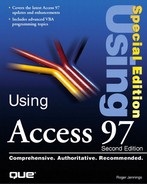Navigating with Hyperlinks
The key to the rapid adoption of the Internet's World Wide Web is the ability to jump quickly from one document to a related document or a particular page of a related document with hyperlinks. If you're reading a North American Web page on consumer electronics products, it's likely that many of the hyperlinks will point to the Web sites of Japanese manufacturers of TV sets, VCRs, and camcorders, such as http://www.sony.co.jp, which usually provide English and Japanese versions of their text content.
Note
On the Web, document and page are synonyms; a Web page basically is a file, usually with an .htm or .html extension, stored in a folder on a Web server. ActiveX documents (formerly called document objects or DocObjects) created by Office 97 applications or Visual Basic 5.0 can be embedded within a Web page, which also may include other text and graphic elements.
Another feature of hyperlinking is the ability to return quickly to prior documents, and then move on to another related document via a hyperlink. It's this forward/backward navigation system that led to the terms Web browsing and browser. To provide improved performance, Web browsers store .htm or .html files with required graphics files (usually as .gif or .jpg files) on your local disk drive, a process called caching. The browser checks to see whether a local copy of the file is present before requesting a download from the Web server.
Hyperlinks and File Paths
Hyperlinks can point to the default home page of a Web site, such as http://www.microsoft.com, or to the default page of an intranet server, as in http://oakleaf0, the IIS 3.0 intranet server used to write the Internet-related chapters of this book. (OAKLEAF0 is the name of the server on which IIS 3.0 is installed.) You don't need to specify the default page, which usually is Default.htm or Index.htm, as in http://oakleaf0/default.htm. You can jump directly to the default page for a specific topic by extending the address entry—for example, http://www.microsoft.com/msaccess or http://oakleaf0/samples/sampsite/default.htm (refer to Figure 16.1).
Hyperlinks to Web pages use relative paths to specify the folders that store HTML pages, graphic images, or scripts that control the customization of pages. For example, the default folder for the content OAKLEAF0 server is C:InetPubwwwroot; the Volcano Coffee Company home page is at C:InetPubwwwrootsamplessampsite. The server name (oakleaf0) you include in the Uniform Resource Locator (URL) for the Volcano home page specifies the first part of the path (C:InetPubwwwroot) for an intranet server. Extended paths in the URL (...samplessampsite) are relative (added) to the default Web server path. Understanding the difference between fully qualified paths (starting with a logical drive letter or \SERVERNAME) and relative paths is very important to your use of hyperlinks with Access 97.
Note
The Internet was developed with and, until recently, dominated by UNIX hosts (servers). The UNIX operating system uses the virgule (forward slash, /) instead of the backslash as the separator in path statements. Another UNIX tradition is the use of lowercase letters for virtually everything, ranging from program names (grep and ftp) to Internet URLs (http://www.microsoft.com). UNIX ordinarily is case-sensitive, which would make InetPub a different folder from inetpub, but URLs and path extensions for Web sites aren't case-sensitive.
Hyperlinks and Intranets
The combination of hyperlinks and browsing capability makes Web browsers effective competitors to custom database front ends created with conventional database development platforms, such as Access and Visual Basic. All Web browsers share a relatively standard, simple interface with button-based navigation. Training costs are minimized because most users already are familiar with browsing the Web. Another advantage of browsers compared with custom database front-end applications is the promise of platform independence. Netscape Navigator runs under 16- and 32-bit Windows, the Macintosh operating system, and the more popular flavors of UNIX. Microsoft promises that updated versions of Internet Explorer for the Macintosh and UNIX will be available later in 1997.
It remains to be seen whether Web browsers will take over the role of forms-based database applications, such as Access 97 or Visual Basic 5.0, for delivering data via private networks. The primary incentive for establishing intranets is quick and easy deployment of new and updated Web pages that take the place of Access forms. For example, you can duplicate the function of the Main Switchboard form of Northwind.mdb with a home page that replaces the form's command buttons with hyperlinks leading to Web pages that imitate the Categories, Products, Suppliers, and Orders forms. If you want to change the Categories page, you only need to copy the page from the Web server, edit and test the page, and then replace the page on the server. To add a new page, you only need to place another hyperlink on the Main Switchboard page. The updating process is considerably easier than altering Northwind.mdb and delivering the new version to every user.
